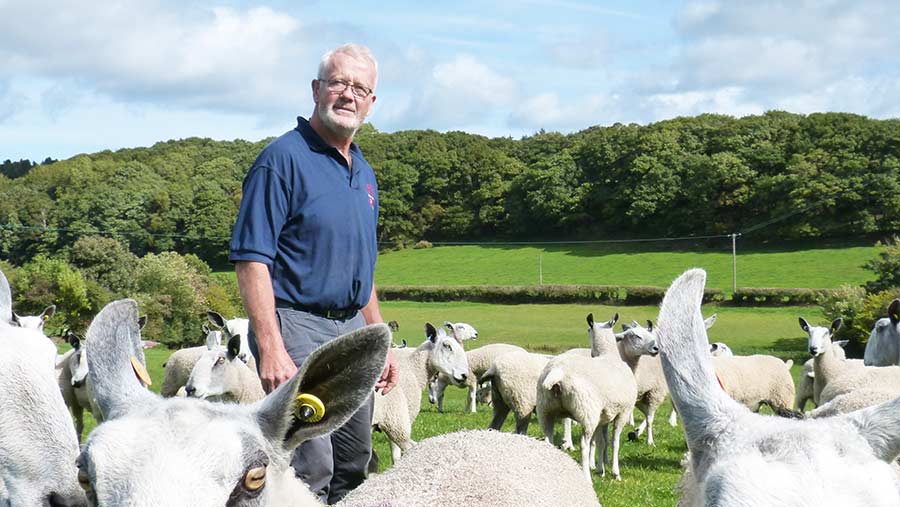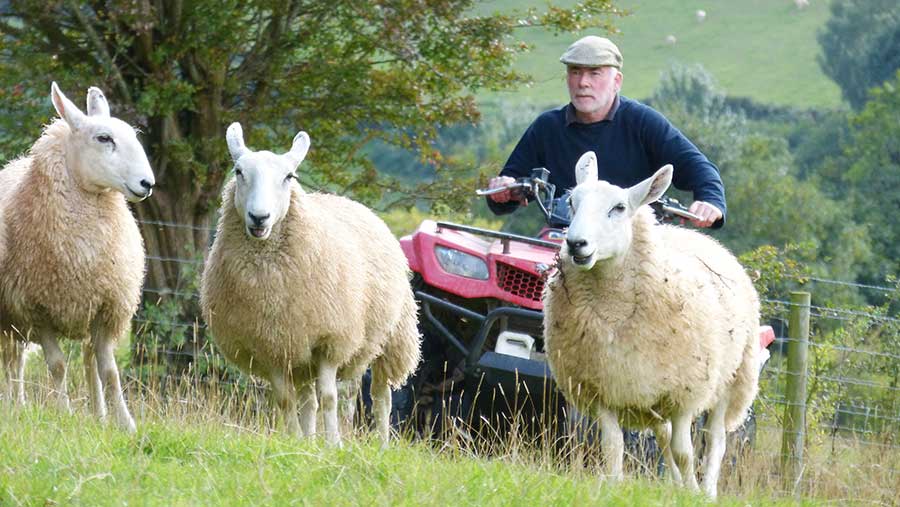How a farmer is improving growth and conformation of sheep
 Elfyn Owen
Elfyn Owen The Cernyw flock of performance-recorded Bluefaced Leicesters is lifting Mule sale weights for its ram buyers by placing a strong emphasis on performance recording and ramping up its ram genetic performance from forage.
Signet records show the Owen family of Ffrith Arw, Llanddogged, has seen the following genetic improvements:
- 0.5kg increase in eight-week-old lamb weights in the past nine years
- 0.35ml increase in muscle depth at scanning in the past nine years
- 0.6kg increase in scanning weights in the past two years
- Only 2-3% of Mule wether lambs fail to hit R- or U-grade, compared with 50% of them grading at Os and Rs 20 years ago
These gains have been made while feeding less concentrate and have been linked to strict culling policies on teeth and paying close attention to muscle and fat depth estimated breeding values (EBVs).
Frith Arw farm facts
- 55 pedigree Bluefaced Leicesters
- 650 improved-type Welsh Mountain ewes
- 200 ewes crossed to Leicester tup annually to sell about 50-100 Mules at Welshpool
- 68ha improved grassland farmed in total (16ha rented)
- 12ha silaging ground and 250-300 Welsh Mountains are kept on winter tack
Since the Cernyw flock began performance recording in 1997, the Owens have made major progress in flock conformation, including breeding Cernyw Muscleman, the ram with the highest muscle depth in the recorded breed.
Alongside Signet recording, father Elfyn and son Ifan’s mantra is that lambs should be reared on minimal concentrate inputs. This has seen concentrate fed to ram lambs reduced by 40-50% in the past six years.
Previously, rams were fed 2-2.5kg a head a day, but ram lambs now receive 0.5kg lambs pellets a head a day, starting a week or two before weaning. They are then given 1-1.5kg of ram mix, pellets and beet pulp in equal parts four weeks before sale at about six months old.
Rams are then paddock-grazed with electric fencing on short-term grass leys of perennial ryegrass and red clover in two- to three-day shifts until ewes are removed at weaning.
The lambs are required to work hard for customers when tupping as lambs and concentrate helps build condition, explains Elfyn, who sells tups to £400-£500 and up to £2,500 to pedigree buyers.
Performance Mules
In 2014, the Welsh Mule Sheep Breeders Association (WMSBA) introduced performance Mules that could be marketed as such if:
- They are out of either a Beulah, Welsh Mountain or Welsh Hill Speckled-face ewe
- They are sired by a top 50% index PR Bluefaced Leicester ram with an index of 97 or more
- In the 2018 index the score must be 125 or more due to improvements in the breed
Leicester ewe management
Most sires bought into the flock are from performance-recorded flocks, but some non-recorded tups are used.
Teasers are used two weeks before ewes are sponged and artificially inseminated, with ewes bred for a total of three cycles before being swept up by a stock ram. Conception rates of 75%+ with frozen semen and 90%+ with fresh semen are achieved in the Bluefaced ewes.
Leicesters are scanned after Christmas and housed according to weekly body condition scoring. A typical scanning result is 200-220%, with one-third of Bluefaced sheep having triplets or quads.
Welsh ewe management
The Welsh Mountain ewes are run as a closed flock and graze the higher parts of the farm up to 305m.
Ewes return from winter ground by early February and are put on grass, blocks and ring-fed silage before an April lambing.
Resulting cross-bred wethers are finished on grass and stubble turnips, with the last batch finished on concentrate. They are sold deadweight to Kepak at 20-21kg in the new year. Scanning is typically 150% and was 164% last year in the Welsh Mountain ewes.
Shearlings are expected to run with 80-100 Welsh ewes, while ram lambs tend to breed 30-40 ewes.
Forage gains
A concerted effort to cut feed buying and improve silage quality has cut quantities of bought-in feed by 60% at Ffrith Arw.
Historically, the farm used 25-27t of feed a year through the winter. However, after adopting 5% magnesium high-energy buckets, feed use has dropped to 9t a year, while stocking 100 more Welsh ewes.
How Ffrith Arw improved forage quality
- Silaged a week earlier to lift energy and digestibility (weather permitting)
- Used fertilisers containing sulphur for past four to five years because of its role in amino acid, vitamin and mineral development
- Increased D-value from 60s to 70+ in silage
- Now aims for 14% protein, 11ME and 70+ D-value
How Ffrith Arw reduced concentrate use
- More regular (weekly) body condition scoring takes place after scanning. Ewes now only receive feed if condition is falling, with one-third of ewes only on 1.1kg/day for the last week before lambing
- Previously, all ewes got 1.1-1.3kg of ewe nut a head a day four to six weeks before lambing
- Paddock-grazing new grass leys has increased the quality of silage and grazed grass on the farm
- High-energy mineral licks with 5% magnesium have been brought into the system
Recorded tups lifting weights and prices for cross-breeder

Gareth Jones
Buying Cernyw rams has lifted Mule lamb weights by 2-3kg on average for commercial sheep breeders Gareth and Eryl Jones, Ty Nant, Eglwysbach.
Historically, Mr Jones drew lambs for Ruthin Mule sales at a maximum of 50kg, whereas 48-50kg is now seen as the average, with the best achieving about 55-56kg in 2017.
The Joneses have bought PR tups for four years since the WMBSA scheme started and have marketed their animals as performance Mules for two years.
Mr Jones, who breeds and sells Mule ewes and Welsh halfbreds, says his customers are also seeing the benefit, with well-grown lambs scanning as high as 135%.
Ty Nant farm facts
- 51ha in total, with 36ha at Ty Nant
- 260 improved-type Welsh Mountain ewes
- 160 crossed to Blue and 100 crossed to Border Leicester
- 70-80 Mules sold as lambs and 45-55 run dry and sold as yearlings
- 60-65 three- to four-year-old draft ewes bought each year from three hill farms in the Cwm Pennant area
High-index sires
Mr Jones sources high-index tups at 150 index or more. All rams are of Cernyw breeding, including one ram each from the Lay and Gornal flocks.
“Choosing a recorded ram versus a non-recorded ram is like choosing between a book you’ve read and one you haven’t,” explains Mr Jones. “Both could be great, but without recording, you are judging the book by the cover alone.”
Each September Mr Jones sells about 70 Mule lambs and 50 dry shearlings at Ruthin in their working clothes after a diet of mother’s milk and forage only. They are walked half a mile to a wagon on a neighbouring farm in all weathers.
“Every year is different,” he adds. “This year our Mule wethers reached 43.5kg three weeks later than last year on 17 July – we are at the mercy of the weather and are always learning.”
Year |
Ruthin lamb average |
Ty Nant average |
|
2015 |
£76.27 |
£95.33 |
|
2016 |
£86.39 |
£103.50 |
|
2017 |
£83.77 |
£106.28 (performance Mules) |
|
2018 |
£73.08 |
£100 (performance Mules) |
Mr Jones marketed his Mule lambs as performance Mules last year and lambs and shearlings as performance Mules this year.
Sheep typically rear 1.5 ewes per 100 ewes tupped and four Bluefaced tups serve 160 ewes. The flock is not scanned.
All sheep lamb outside from 1 March (most lambing 14-24 March), with sheep and lambs temporarily housed for 12-48 hours if necessary.
Bluefaced tups are fed an 18% protein ram lamb mix for four weeks before tupping. Amounts are built up to 1kg feeds twice a day.
